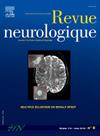SEEG 在核磁共振成像正常的颞叶中段癫痫患者手术前决策过程中的作用。
IF 2.8
4区 医学
Q2 CLINICAL NEUROLOGY
引用次数: 0
摘要
目的:对于磁共振成像(MRI)正常的颞叶间叶癫痫(mTLE)患者,由于术后记忆缺失的风险,可能会考虑行颞叶前部切除术,但要保留海马。然而,目前尚不清楚的是,一些核磁共振成像正常、无创脑电图和符号学模式高度提示颞叶中叶癫痫发作的患者是否表现出癫痫发作网络,从而可能需要进行手术:对17名磁共振成像正常、接受SEEG检查的mTLE癫痫患者进行回顾性研究。只有非侵入性手术前数据显示单侧颞中叶致痫区(EZ)的患者才被纳入研究,该致痫区是由发作期半身像和发作期头皮视频脑电图共同定义的。采用视觉和定量方法对 SEEG 数据进行分析。定义了两种 EZ 组织:(i) EZ 在发作放电开始时涉及海马(HIP 组):(ii) 在发作开始和涉及海马之间观察到延迟>1 秒的患者(nHIP 组)。对各组的非侵入性临床和功能成像数据以及术后结果进行比较:结果:11 名患者被纳入 HIP 组,6 名被纳入 nHIP 组。在 nHIP 组中,5 名患者的最大致痫区在杏仁核,1 名患者的最大致痫区在内侧皮层。海马正常化发作间期尖峰活动在各组之间没有差异。在非侵入性手术前检查中收集的患者特征均与基于 SEEG 的 EZ 组织无关。12 名患者接受了手术切除,其中 6 人接受了颞叶皮质切除术,保留了海马。癫痫发作和神经心理学术后结果相似:结论:对于磁共振成像正常的mTLE患者,手术决策过程中应包括SEEG,因为非侵入性检查无法预测发作组织。结论:对于磁共振成像正常的 mTLE 患者,手术决策过程中应包括 SEEG,因为非侵入性检查无法预测发作组织。如果 EZ 中不包括海马,则可考虑颞叶切除,但要保留海马。本文章由计算机程序翻译,如有差异,请以英文原文为准。
The role of SEEG in the presurgical decision-making process in MRI-normal mesial temporal lobe epilepsy
Objectives
In patients with mesial temporal lobe epilepsy (mTLE) and normal MRI, anterior temporal lobectomy sparing the hippocampus might be considered because of the risk of post-operative memory deficit. However, it is unclear whether some patients with normal MRI and non-invasive EEG and semiological pattern highly suggestive of mesial temporal seizures demonstrate a seizure onset network sparing the hippocampus, potentially warranting surgery.
Methods
A retrospective study of 17 patients with mTLE epilepsy and normal MRI who underwent SEEG. Only patients whose non-invasive presurgical data suggested an unilateral mesial temporal epileptogenic zone (EZ), as defined by combination of ictal semiology and ictal EEG during scalp video-EEG, were included. SEEG data were analyzed using both visual and quantitative approaches. Two EZ organization were defined: (i) EZ involved the hippocampus at the onset of the ictal discharge (HIP group): (ii) patients in whom a delay > 1 sec was observed between the seizure onset and the involvement of the hippocampus (nHIP group). Non-invasive clinical and functional imaging data, as well as post-operative outcomes, were compared across groups.
Results
Eleven patients were included in HIP group and 6 in the nHIP group. In the nHIP group, the maximal epileptogenicity was in the amygdala in five patients and in the entorhinal cortex in one. The hippocampus normalized interictal spiking activity was not different between groups. None of the patients characteristics collected during the non-invasive presurgical workup was associated with the SEEG-based organization of the EZ. Twelve patients underwent a surgical resection, including temporal cortectomy sparing hippocampus in six. Seizure and neuropsychological post-operative outcomes were similar.
Conclusion
In patients with MRI-normal mTLE, SEEG should be included in the surgical decision-making process because seizure organization cannot be predicted from non-invasive investigations. When hippocampus is not included in the EZ, temporal resection sparing the hippocampus can be considered.
求助全文
通过发布文献求助,成功后即可免费获取论文全文。
去求助
来源期刊

Revue neurologique
医学-临床神经学
CiteScore
4.80
自引率
0.00%
发文量
598
审稿时长
55 days
期刊介绍:
The first issue of the Revue Neurologique, featuring an original article by Jean-Martin Charcot, was published on February 28th, 1893. Six years later, the French Society of Neurology (SFN) adopted this journal as its official publication in the year of its foundation, 1899.
The Revue Neurologique was published throughout the 20th century without interruption and is indexed in all international databases (including Current Contents, Pubmed, Scopus). Ten annual issues provide original peer-reviewed clinical and research articles, and review articles giving up-to-date insights in all areas of neurology. The Revue Neurologique also publishes guidelines and recommendations.
The Revue Neurologique publishes original articles, brief reports, general reviews, editorials, and letters to the editor as well as correspondence concerning articles previously published in the journal in the correspondence column.
 求助内容:
求助内容: 应助结果提醒方式:
应助结果提醒方式:


